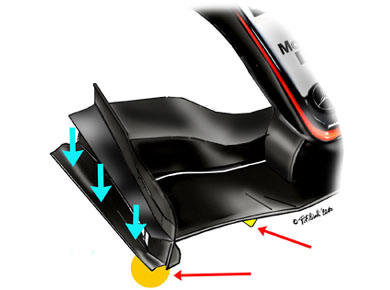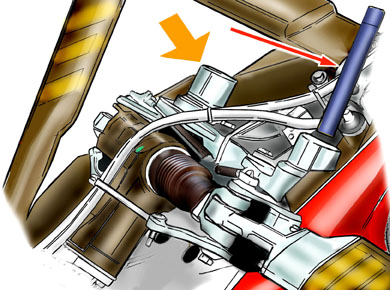Sunday, May 22, 2005
MONACO GP 2005 TECHNICAL ANALYSIS

Red Bull RB1 - front suspension
A new suspension layout for Monaco, with the upper front wishbone acting as a large wing profile, about 25 cm across at its widest section and 8 cm thick. This front arm, which includes the steering link, provides additional front-end downforce, invaluable at this twisty track.

Ferrari F2005 - front wheels 'ears' and horizontal disc holes
A detail change for Monaco - a tiny, wing-like structure inside the top of the front-brake cooling drum. Two horizontal holes (blue arrows) allow air circulation, almost like small air intakes for the brake callipers. As the structure turns with the wheel it also acts as a mobile winglet, providing a small but constant increase in front grip. Its overall width is 12cm, the maximum allowed for brake air intakes. Another change is the holes in the edge of the brake disc, which now run across the edge rather than along it, with each an 'eight' shape rather than oval. These changes improve thermal heat exchange through the disc's side walls.
Aero changes for Monaco include the addition of a vertical fin under the main profile (in yellow), acting as an airflow splitter, and a change to the shape of the lower channel on the endplates (in orange). The channel now has a flatter upper edge (previously semi-circular). The modifications help reduce the car's pitch sensitivity, improving its front-end sharpness, which is vital in the tight corners of Monte Carlo.

Renault R25 - additional side winglets
A completely revised Renault aero package for Monaco. The sidepod winglets have been doubled up, with an extra lower element (bottom red arrow). A small flap (top red arrow) has also been added to the rear of the upper winglet, connected by a new vertical endplate. All this provides vital additional downforce - crucial on the narrow streets of the Principality.
For Monaco the central 'box wing' loses its upper profile (2). This reduces the car's pitch sensitivity under braking, and the small loss of front downforce is recovered by adding ballast inside the bottom of the nose cone. This has slightly changed the overall balance of the car, while maintaining its sharpness into corners, a quality paramount at this track. The largely unchanged endplates now sport a single, small horizontal winglet (1).

Toyota TF105 - additional front winglets
To increase downforce at Monaco, extra winglets have been mounted using tiny pillars on top of the main front wing profiles. The concept is similar to Renault's front wing at Imola, but the look is somewhat stranger, closely resembling elements normally atop sidepods. The effect is to add front-end sharpness to the car on entry to corners.

Monaco set-up - increased steering angles
Negotiating Monaco's tight confines requires greater steering angles (2) than normal (1). To allow for this, the front suspension is modified, cutting into the wishbones (yellow) to stop the wheel rims touching them. To compensate, additional carbon-fibre reinforcements keep the structure solid and ensure it withstands the huge stresses caused by the bumps and accelerative and braking forces.
Monte Carlo's bumpy circuit forces teams to use greater ride heights, close to those normally reserved for wet conditions. To absorb the bumps, damper (orange arrow) and torsion bar (in blue) settings are softer. This makes the car easier to drive in tight corners. The downside is reduced aero efficiency, but this is of little relevance here due to the low average speeds.

Monaco set-up - additional fins
Many of the aero features traditionally reserved for the ultra-high downforce Monaco circuit are now used everywhere thanks to the 2005 regulations. Examples are the mid-wings and additional profiles shown by the small, red arrows. This year in Monte Carlo, the teams are likely to concentrate on adding fins and winglets on the sidepods (yellow-circled area).


